How to make a cat gate for stairs? Creating a cat gate for your stairs can be a clever way to keep your feline friend safe and restrict access to certain areas of your home.
If you’ve noticed your cat’s ninja-like ability to climb or jump over most barriers, you’re not alone.
With over 60% of cat owners looking for indoor solutions to keep their pets secure, you’re taking the right step.
But before you start, you’ll need to understand your space and your cat’s behavior to tailor a solution that works.
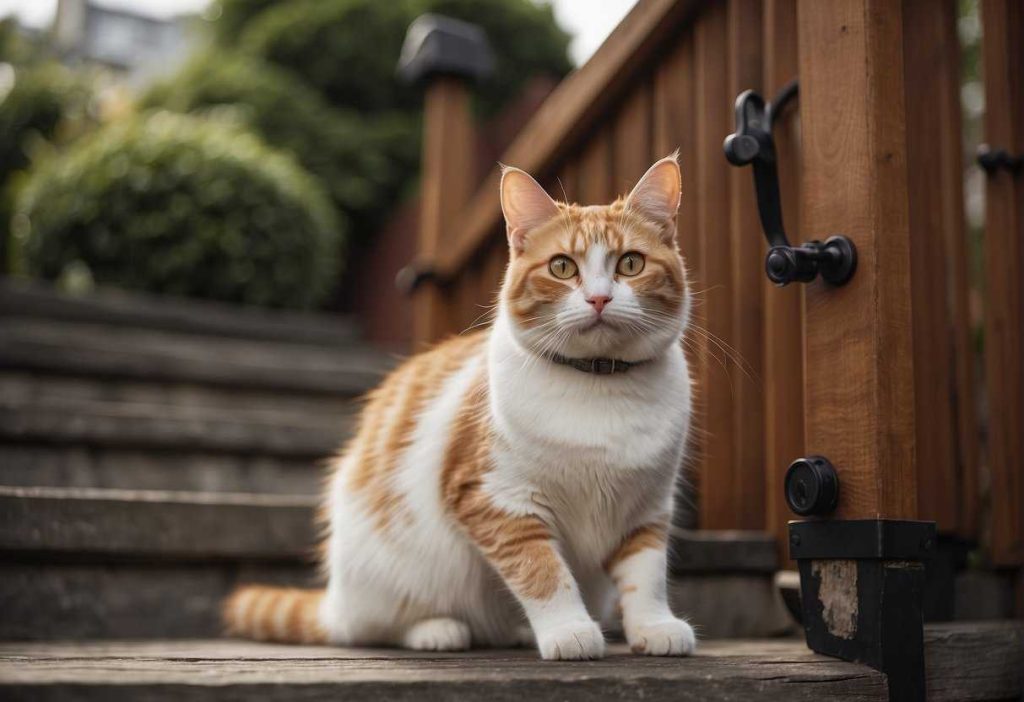
Getting the right materials and tools is crucial for building a sturdy and effective gate. You want to avoid the frustration of a gate that’s easily knocked down or jumped over.
Plus, if you’re a bit of a DIY enthusiast, this project is a perfect weekend activity.
Remember that time when a friend of yours crafted a DIY cat gate and suddenly their life became easier, with no more cats on the wrong side of the stairs?
That could be you, with just a bit of planning and some simple construction steps.
Key Takeaways
- Building a cat gate helps prevent cats from accessing unsafe areas.
- Over 60% of cat owners need indoor pet safety solutions.
- Choosing the suitable materials and following a detailed guide ensures effective gate construction.
Assessing Your Space and Cat’s Behavior

Cats love to climb and pounce — with some furry pals, like the impressive Bengal, able to vault up to six times their body length. (1)
That’s Olympic-level jumping right in your living room! This means a taller gate might be on your shopping list if you have a high-flying Bengal. (2)
Have you taken a good look at your stairs? Here’s how to get the perfect measurements for that soon-to-be cat gate:
- Grab a tape measure and jot down the width of your stairway.
- Measure the height you’ll need; keeping in mind those acrobatic Bengal benchmarks!
- Note any funky steps or unique features—quirks in staircase design can call for a custom approach.
Imagine you’re in a home where history whispers from every nook and cranny, and the staircase? It’s as unique as they come.
That’s precisely when a made-to-measure solution shines, crafting a gate that fits like a glove while honoring that timeless charm.
Keeping a short, but sweet record of your cat’s behavior along with the stairway specifics can save you time and headaches.
Will a standard gate cut, or is your whiskered high-jumper plotting their next great escape?
It’s all about securing stairs without stifling style or your kitty’s curious nature!
Choosing The Right Materials and Tools
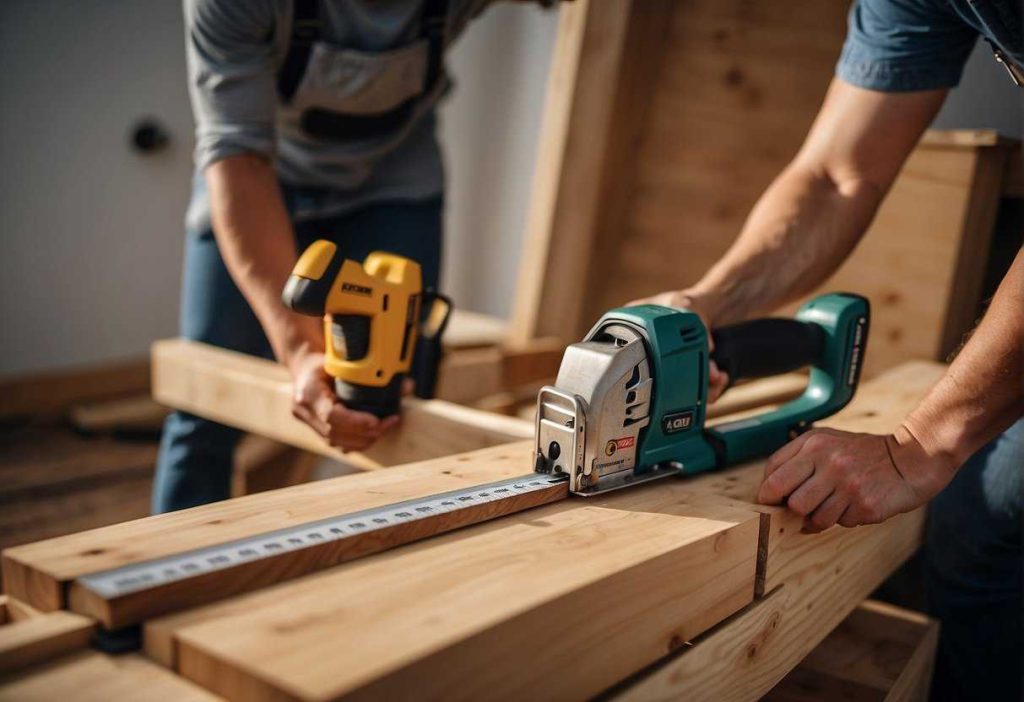
Let’s talk about crafting the purrfect cat gate for stairs. You’ll want to strike a balance between durability, style, and safety.
When pondering materials, consider these three contenders: wood, PVC, and metal. (3)
Wood offers a classic look and can be customized with paint or stains but isn’t as chew-resistant as other materials. (4)
PVC is lightweight and easy to clean, though it may not withstand a ferocious feline’s full pounce. (5)
Metal stands as the champion of durability, but here’s the twist: it might need a soft touch, like padding, to keep kitty cozy and safe. (6)
Speaking of safety, don’t forget yours! Gear up with gloves, goggles, and a trusty dust mask when slicing and dicing your chosen materials.
Now, here’s a nifty table to guide you along:
| Material | Pros | Cons | Best For |
|---|---|---|---|
| Wood | Customizable, warm aesthetics | Not very chew-resistant | Style-savvy pet owners |
| PVC | Lightweight, easy to clean | Less durable | Indoor use or gentle pets |
| Metal | High durability, strong | Needs padding for safety | Boisterous or larger cats |
Now, a quick rundown of your toolkit essentials—you wouldn’t want to be caught without these:
- Measuring Tape: Precision is key; get those measurements spot on!
- Saw: Whether manual or electric, choose one that can handle your material with ease.
- Drill: For assembling like a pro.
- Screws: They’ll be holding the fort together, quite literally.
- Hinges: These little heroes will give your gate the swing it deserves.
Trust me, I’m not screwing around when I say you need a good screwdriver.
It’s the unsung hero of DIY projects. Remember to match your screws and screwdriver to avoid a headache.
Finally, a simple checklist:
- Measuring Tape
- Saw
- Drill
- Screws
- Hinges
- Screwdriver
- Safety Equipment (gloves, goggles, dust mask) (7)
Armed with the right materials and tools, you’re set to create a gate that’s the cat’s whiskers!
Designing Your Cat Gate
Customization for Safety and Aesthetics
First things first, you want to make sure your cat’s new barrier is a haven, not a hazard. Double-check your design to ensure there are:
- No Sharp Edges: Round off any sharp corners to prevent injuries.
- Small Gap Prevention: Ensure gaps are small enough so your cat can’t squeeze through or get stuck.
Now, who said safety can’t look good? Let’s get creative:
- Stain to Gain: Staining wood can give your gate that warm, natural feel that blends effortlessly with your home décor.
- Metal with Mettle: If you’re going for strength with a modern twist, decorative metal can be both robust and eye-catching.
Planning Your Gate Design
Do you have a narrow staircase? Consider a sliding gate design; it’s sleek and saves space.
For those with wider staircases, a swing gate provides ease of use and can be designed to complement your home’s unique style.
How about visualizing before building? Sketching out:
- A detailed diagram of your sliding and swing gate designs will ensure you’ve got all angles covered.
Remember, your cat gate should be like a friendly neighbor, there to help but also pleasant to look at.
By focusing on design elements that address safety while enhancing aesthetics, you’re on track to creating a bespoke gate that’s just purr-fect!
How to Make a Cat Gate for Stairs: Step-by-Step Building Guide
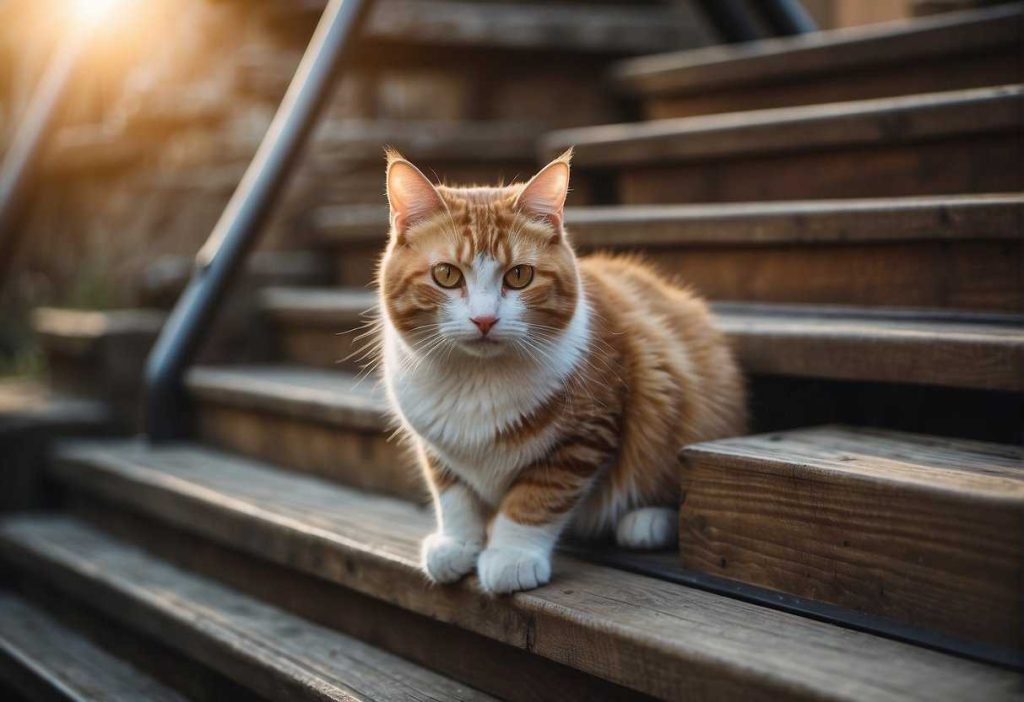
Preparing the Materials
First things first, let’s gather all the materials you’ll need for your cat gate. Do your wood or PVC pipes? Good. You’ll want to measure twice and cut once to get the perfect length.
If you’re unsure about using a handsaw or circular saw, check out a tutorial.
Now, onto the connectors or brackets—they’re crucial for stability, so watch a video tutorial on assembling these pieces like a pro.
Installation Process
Alright, it’s time to get this gate up.
If you’re using a traditional gate that needs to be attached to the walls, start by drilling pilot holes for those hinges.
This will make attaching the gate a breeze and help avoid any splitting. But if you’re in a rental or just not into making holes in your walls, seek out a pressure-mounted gate instead.
It’s like magic—no drilling required!
Safety Checks and Adjustments
We’re almost there! Safety first:
- Stability? Check.
- Sharp edges? None.
- Latch security? Solid.
Give it a good wiggle to be sure.
If your gate starts to act like it’s had one too many treats and begins sagging, tweak those tension rods or tighten up the hinges.
And there you go, a sturdy cat gate is ready to stand guard at the stairway!
Keep these pointers in mind to ensure everything goes smoothly, and you’ll have the perfect DIY barrier to keep your adventurous feline safe.
Reference Guides For Pet Owners
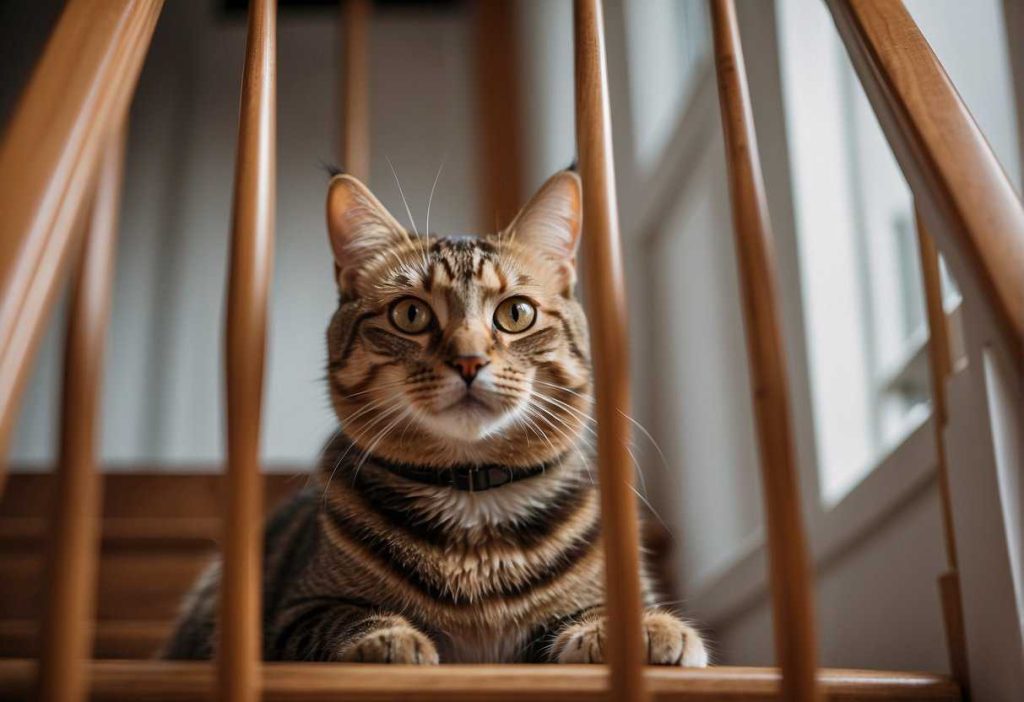
Cats can often sustain injuries from unguarded stairs. A hefty number of feline mishaps are stair-related. It makes a sturdy, secure gate not just a nice-to-have, but a must-have!
Soft Edges on Cat Hangouts:
- Add padding to shelves or furniture near the stairs.
- Cushion the edges of your gate with foam or soft fabric.
Planning for Long-term Usability:
- Select durable, weather-resistant materials for outdoor gates to save future headaches.
- Implement a maintenance schedule — tighten those fittings every 6 months to keep things snug and secure!
Matching the Gate to Your Cat’s Behavior:
- Quiz Time: Is your cat a jumper or a climber? Answer this to determine the gate height!
- Success Story: A custom gate once prevented a Houdini cat from escaping — a sigh of relief for the owner!
Now, ready to build that perfect gate for your stairway admiral?
Additional Considerations
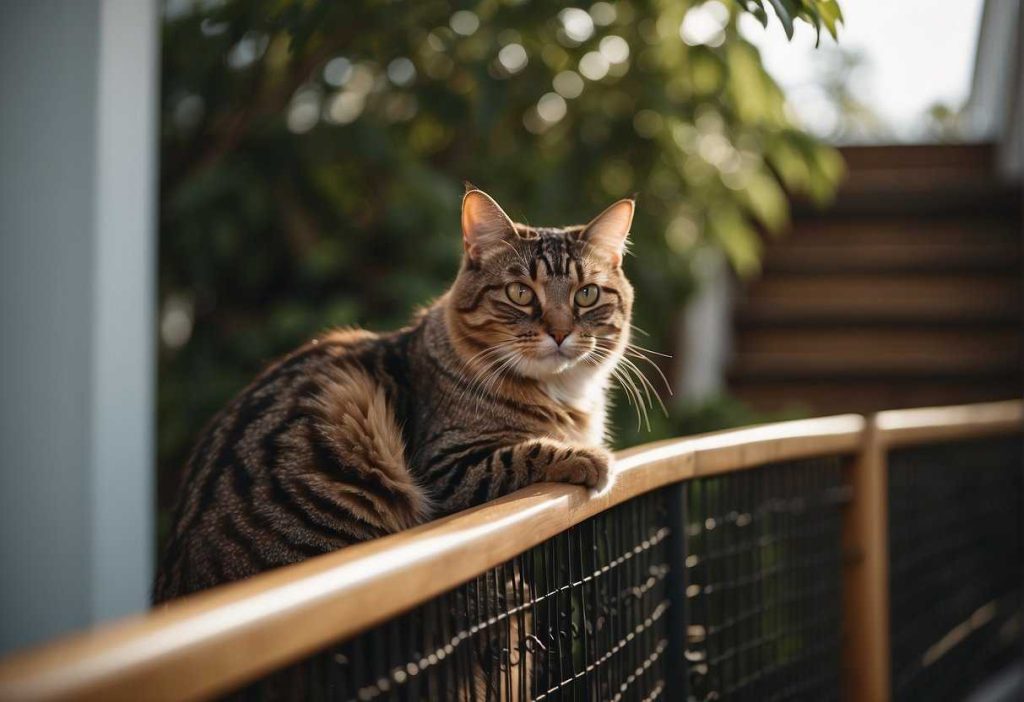
DIY Challenges and Solutions
Have you wrestled with warped wood or uneven cuts while crafting? Fret not! It’s common to encounter these snags, but with a few tricks up your sleeve, you can conquer them.
If your wood looks more like a roller coaster than a flat plank, use brackets for extra stability. Did your saw leave a jagged legacy? No worries, a bit of sanding will smooth out those rough edges.
Remember, a well-built gate stands strong and looks sharp!
Maintenance and Upkeep
Ever wonder how to keep your cat gate as spry as your feline friend? Regular cleaning is key, along with routine checks for signs of wear and tear—no one likes a rickety gate!
And while cats don’t care for curb appeal, you might. After about a year, give that wooden gate a dashing new coat of paint. It’s not just for looks; it’s a chance to inspect for hidden damage.
Plus, it’s a great weekend project—throw on some music and make it your me-time!
Don’t let DIY deter you; with the right care, your cat gate can be a steadfast sidekick to your stairway. Keep it smart, keep it safe, and let your craftiness shine!
Quick Recap
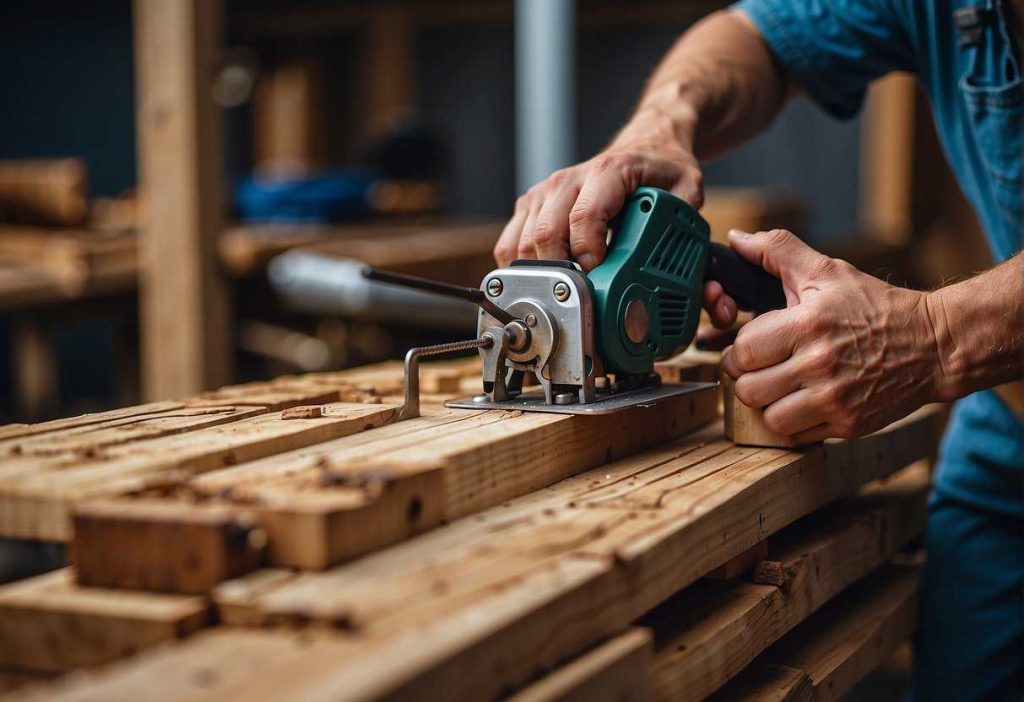
Feeling crafty? Let’s do a quick run-through of what you’ve accomplished so far:
- Design: You’ve drawn up a plan. Remember, whether you’re thinking sleek modern, or charming rustic, your design reflects your flair.
- Materials: Gathered your supplies, right? Wood, hinges, screws, and maybe that splash of paint for some color.
- Measure Twice, Cut Once: Precision is your friend. Ever heard of a cat that tolerates sloppy work?
- Assembly: You’ve lined up those pieces and put them together. Goodbye, wonky angles!
- Safety First: Smoothed out the edges—no splinters allowed in those precious paws.
- Installation: That gate’s not going to hang itself! Installed it securely so it stands guard like a sentinel.
Got all that down? Great!
Tailoring time—did you tweak things a bit? Maybe a little cutout for your feline to peek through? It’s all about making it work for you and your whiskered wanderer.
Balancing act—admit it, you’re more than a little pleased with how it’s turned out—a perfect blend of ‘cat-proof’ and ‘compliments my décor’.
Remember, you’ve got this. Building a cat gate is not just about functionality; it’s about crafting a space that’s safe for your kitty and fits your style. Go ahead, give yourself a pat on the back and a nice cup of tea.
Your cat, undoubtedly, is already planning their next great adventure—safely behind your fabulous new gate!
Frequently Asked Questions

Curious about crafting a cat gate that rivals store-bought ones? Well, you’ve come to the right place. Let’s tackle some of the questions you might have to get that purr-fect barrier up and running.
What are some effective DIY methods for creating a tall cat gate?
Lucky for you, PVC pipes offer a simple framework to build a tall cat gate. The structure can be secured with PVC joints and fastened with screws to ensure it stands firm.
Another option includes using old baby gates and enhancing their height with mesh or additional wooden slats.
Can you recommend a way to build a cat-proof barrier without using a traditional gate?
Certainly! Consider using thick clear plastic sheets as they offer visibility and flexibility.
Cut to the desired size and fasten them to the wall using adhesive hooks or Velcro strips. This creates a sleek barrier that keeps curious kitties at bay.
What’s the best approach to constructing a wooden gate for keeping cats away from stairs?
Your best bet is to use sturdy wood planks. Measure the width of your staircase, cut the planks to size, and assemble them with hinges for a swinging gate.
Don’t forget a latch to keep it closed! Staining or painting the wood can also add a classy touch to your craftsmanship.
What solutions exist for placing cat barriers at critical entry points like doorways or the front door?
Get creative with repurposing furniture like bookshelves or a folding screen. Position them to obstruct the area—these not only act as barriers but also blend seamlessly with home decor.
Alternatively, tension rods and drapery can block off sections without installing permanent fixtures.
How can I make a retractable barrier that’s suitable for containing adventurous cats?
One nifty solution is a roller shade made from durable fabric attached to one end of the doorway.
It can be pulled across when needed and retracted when not. Ensure the bottom is weighted or secured with hooks.
Are there alternative materials or designs I can consider for a cat barrier when stair gates aren’t working?
For sure, you could try netting, which provides a less obstructive view. Secure it with eyelet screws and cables for a tight fit that’s still aesthetically pleasing.
Some folks use magnetic screens which are as effective at keeping pets in as they are at letting fresh air through.
Can the cat gate be portable or easily removable?
Yes, it can! Consider using interlocking playpen sections that can be taken apart and moved around easily.
They’re not just for kids, you know. Plus, they can be pieced together to fit various sizes and shapes of spaces, handy right?
- The Ultimate Overview to Actual Cash Gambling Establishments - July 1, 2025


